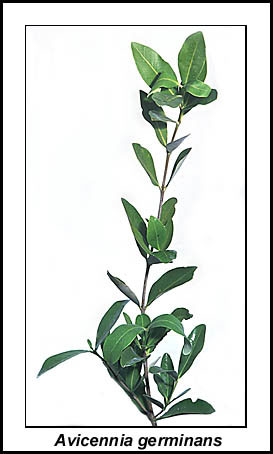Black Mangrove
Avicennia germinans
Family: Acanthaceae
Natural History

Black mangrove is a communal species that plays a key role in the mangrove ecosystem. It contributes to the ecological community by trapping in the root system debris and detritus brought in by tides. The community is valued for its protection and stabilization of low-lying coastal lands and its importance in estuarine and coastal fishery food chains. Black, white, and red mangroves serve as feeding, breeding, and nursery grounds for a great variety of fish, shellfish, birds, and other wildlife.
Black mangrove grows in coastal tidal areas throughout the tropics and subtropics of America and Africa. It grows closer inland from the shore. There it can be reached only by high tides. It is found on the gulf coast of Florida from Cedar Key to Key West and back up to St. Augustine on the Atlantic side. Southwest Florida islands contain the most concentrated area of mangroves. The tree becomes shrubby toward the north of its range due to the cooler weather. Freezing temperatures prevent the range from extending northward.
The wood is dark-brown to nearly black. It is preferred for its strong, heavy, and hard qualities. Black mangrove wood has been used as posts, fuel, and for marine construction. Black mangrove contains tannin in the bark and has been used to prepare leather products.
Black mangroves bloom in June and July with white flowers. When in bloom, black mangrove nectar is used for "mangrove honey" production. This honey is of very high quality. Considerable quantities were made in the United States until about 1895. Hurricane destruction of the best forests decreased honey production. In recent years, there has been renewed interest in this product.
Black mangroves can be easily identified by the numerous pencil-like breathing tubes, called pneumatophores, which grow vertically from the mud to just above the highest sustained water level. Like the prop roots of the red mangrove (Rhizophora mangle), these provide air to the underground and underwater roots. Unfortunately, the diverse natural community provided by the mangrove forest is declining due to the invasion of overpowering plant species, such as the Brazilian pepper, and urban development.
